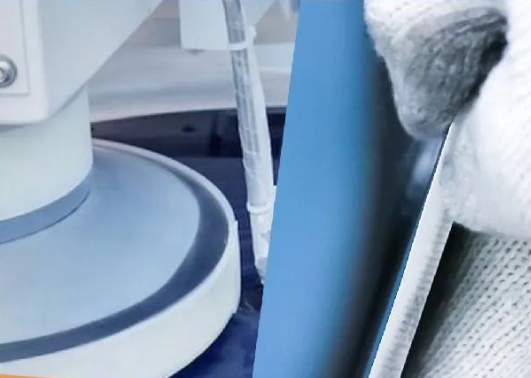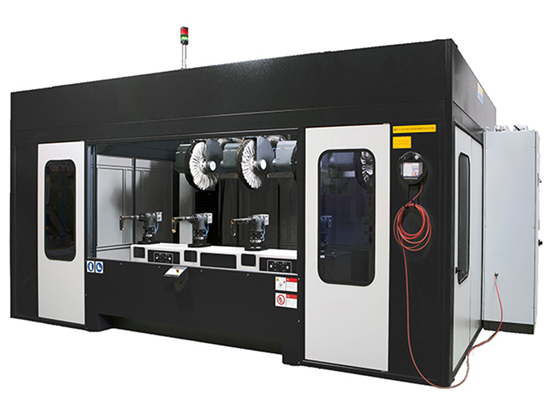
This article is also available in the following languages:
繁體中文
How much do you know about the surface treatment process? Today we will find out!
Polishing
Polishing is the use of flexible polishing tools and abrasive particles or other polishing media to treat the surface of a workpiece to improve the accuracy of the dimensionality or geometry of the workpiece and to obtain a smooth surface or mirror finish.

* Our company has extensive experience in polishing, polishing surface treatment process has related cases, can provide customers with a complete polishing program. If you have needs, you can scan the QR code at the end of the page to contact our customer service.
Metal wire drawing
Metal wire drawing is a surface treatment that forms lines on the surface of a workpiece by polishing the product. Depending on the grain, it can be classified as straight wire drawing, random wire drawing, corrugated wire drawing, and spiral wire drawing, as well as sun grain processing and hairline processing.
In recent years, a growing number of products have used the metal drawing process to create beautiful, erosion-resistant metal shells.

Micro-arc oxidation
Micro-arc oxidation, also known as plasmonic electrolytic oxide surface ceramic technology. It refers to the method of enhancing and starting the reaction on the anode by arc discharge on the basis of ordinary anodic oxidation, so as to form a high-quality strengthened ceramic film on the surface of the workpiece with aluminum, titanium, magnesium and other metals and their alloys as materials.

Blueing
Blueing, also known as the point blue process, is to fill the whole carcass with color glaze, and then take the furnace temperature of about 800℃ in the blast furnace to bake.
The color glaze is melted by sand granular solids into a liquid, which cools to a gorgeous color glaze fixed to the carcass. At this point the color glaze is lower than the height of the copper wire, so it has to be filled again, and then sintered, four or five times, until the pattern is filled to a level with the grain.


Shot blasing
Shot blasing is a cold working process in which the surface of the workpiece is bombarded with pellets and residual compressive stress is implanted to increase the fatigue strength of the workpiece. Extensively used to improve the mechanical strength and wear resistance, fatigue resistance and corrosion resistance of components.


Sand blasting
Sandblasting is the use of compressed air as the power to form a high-speed jet beam to spray the spray material (copper ore, quartz sand, emery, iron sand, Hainan sand) high-speed spray to the surface of the workpiece to be treated, due to the impact and cutting effect of abrasive on the surface of the workpiece, so that the surface of the workpiece to obtain a certain degree of cleanliness and different roughness, the mechanical properties of the workpiece surface can also be improved.

Etching
Etching is the process of removing material by chemical reaction or physical impact. The etching technique can be divided into wet etching and dry etching.
Often referred to as etching, also known as photochemical etching, it involves the removal of a protective film from an etched area by exposure plating and development, and the exposure to a chemical solution during etching to achieve the effect of dissolving corrosion, creating a concave and convex or hollow form effect.


IMD
IMD (In-Mold Decoration technology), also known as no-coating technology, is an international popular surface decoration technology.Its surface-hardened clear film, middle print pattern layer, back injection layer, and ink center make the product resistant to friction, prevent the surface from being scratched, and can maintain a bright color that does not easily fade over time.

OMD
Out Mold Decoration is a visual, tactile, and functional integrated display that is an IMD extension of the Decoration technology, which is a combination of the printing, texture structure, and metallization properties of 3D surface decoration technology.

Laser engraving
Laser engraving, also known as radium engraving or laser marking, is based on numerical control techniques with lasers as the processing medium. The physical denaturation of the processed material during instant melting and gasification under laser etching irradiation can enable laser etching for processing purposes.
Laser engraving is the use of laser technology to write text on an object, a technique that engraves the word without marking, leaving the surface of the object still smooth and the writing undamaged.

Electrical discharge machining
During EDM, the tool electrode and the workpiece are connected to the poles of the pulsed power supply, respectively, and immersed in the working liquid, or the working liquid is filled into the discharge gap. When the gap between the two electrodes reaches a certain distance, the applied impulse voltage on the two electrodes breaks down the working liquid and creates a spark discharge.
The electrode electrodes commonly used have good electrical conductivity, high melting point, and are easy to work with electrical corrosion resistant materials such as copper, graphite, copper-tungsten alloys, and molybdenum. There is also a loss in the tool electrode during the process, but this is less than the amount of corrosion in the workpiece metal, and is even close to no loss.

Laser texturing
Laser texturing is treated with high energy density lasers and steel surfaces to form snakeskin, etch, pear, or other forms of grain.

Transfer printing
Transfer printing can print text, graphics and images on the surface of irregular objects, which belongs to one of the special printing methods, that is, the use of steel (or copper, thermoplastic plastic) gravure plate, the use of silicon rubber materials made of curved pad head, the ink on the gravure plate dipped into the surface of the pad head, and then to the surface of the required object can be printed text, patterns, etc.

Silk screen printing
Silk screen printing refers to the use of a screen as a plate base, and to the manufacture of photographic plates by means of photographic plate-making, made from photographic screen plates. Screen printing consists of five elements, a screen plate, a scraper, ink, a printing table and a substrate. Using the basic principle of screen printing plates, the graphic part of the mesh can be printed with ink, but the non-graphic part of the mesh cannot.
When printing, ink is poured into one end of the screen plate, and a certain pressure is applied to the ink part of the screen plate with a scraper, and the ink is moved at a uniform speed toward the other end of the screen plate, and the ink is squeezed by the scraper from the mesh of the graphic part to the substrate.

Direct thermal printing
Direct thermal printing refers to the thermal sensitive agent is coated on paper, so that it becomes a thermal recording paper, thermal recording paper under the action of heat, the substance (color developer) physical or chemical properties change and get an image method.

Thermal transfer printing
The principle of thermal transfer printing is that the digital pattern is printed on the transfer paper with a special transfer ink through the printer, and then the special transfer machine is used to accurately transfer the pattern to the surface of the product at high temperature and pressure to complete the product printing.

Planographic printing
Planographic printing, an indirect method of printing, was developed and named by the early lithographers, whose early lithographic plates, after application, were ground with stone, and then improved to use metal zinc or aluminum plates as plate materials, but the principle remained the same.
Since the graphic part and the non-graphic part of the planographic printing are on the same plane, in order to make the ink distinguish the pattern part of the printing plate or the non-graphic part, the principle of oil-water separation is used, and the water supply device of the printing plate component is first supplied to the non-graphic part of the printing plate, so as to protect the non-graphic part of the printing plate from the ink wetting.

Then the ink supply device of the printing part supplies ink to the plate, and as the non-graphic part of the plate is protected by water, the ink can only be supplied to the graphic part of the plate. Finally, the ink from the plate is transferred to the milkskin, and the pressure between the rubber roller and the embossing cylinder is used to transfer the ink from the milkskin to the substrate to complete a print.
Curved surface printing
Curved surface printing is a general term for printing a substrate with a curved shape. Most used to print cylinders or cones of metal, plastic, glass containers or shaped objects.
The ink is first put into the engraved text or pattern gravure plate, and then the text or pattern is copied on the curved surface, and then the curved surface is transferred to the text or pattern on the surface of the molded product, and finally the ink is cured by heat treatment or ultraviolet light irradiation.

Hot stamping
Hot stamping, commonly known as “bronzing”, refers to the text and pattern of colored foil and other materials on the first or fourth seal of the hardcover book shell, or the hot pressing method to imprint various convex and concave title or pattern.

Water transfer printing
Water transfer printing is a type of printing that uses water pressure to hydrolyze transfer paper and plastic film with color patterns. The 2D expansion was printed using a common inkjet printer on a water-transfer film that was spread over water, allowing the film to wrap around the model in both water and color.

Flat screen printing
Flat screen printing, the printed fabric is transferred to the screen through a wide rubber band, rather than being placed on a long table (as is the case with manual screen printing). Like manual screen printing, automatic screen printing is an intermittent process. During this process, the fabric is moved under the screen, then stopped, and the net scraper automatically scratches, after which the fabric continues to move under the next frame.

Satin-finishing
Satin-finishing are also called press polish. The last step of refinishing. Using the plasticity of the fiber under mixed heat conditions, the surface of the fabric is flattened or rolled out in parallel thin diagonal lines to improve the finishing process of the fabric gloss.
Once the material is fed, it is heated and melted, then shaped into sheets or films, which are cooled and rolled. The most commonly used rolling material is polyvinyl chloride.







